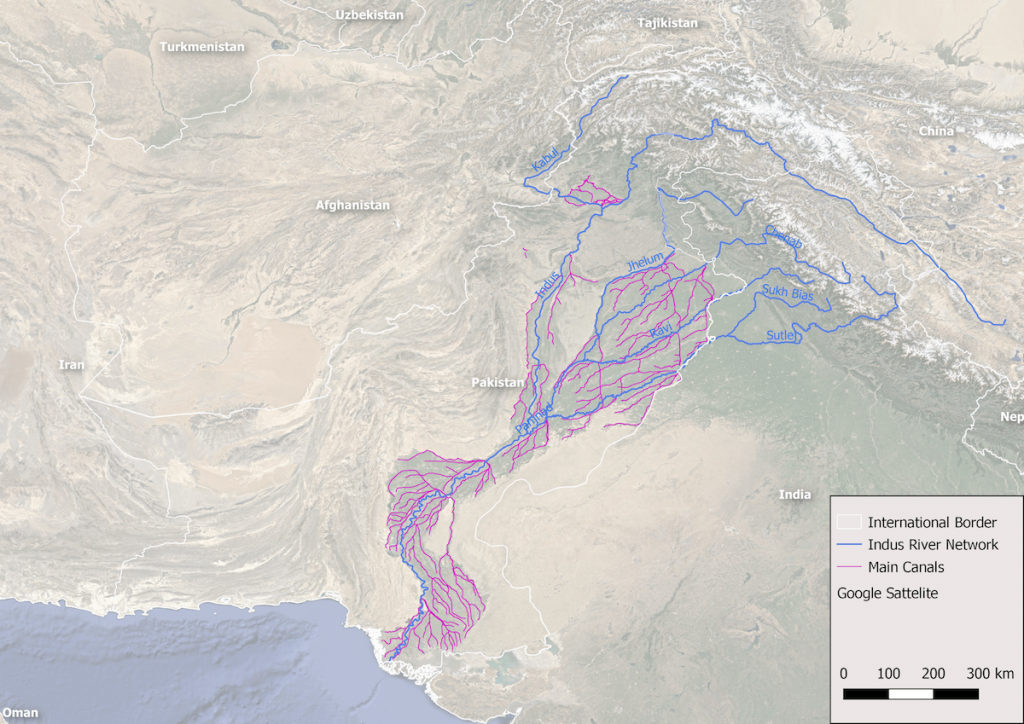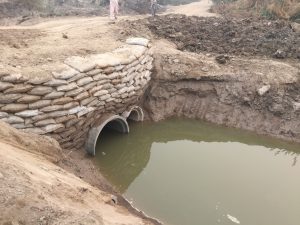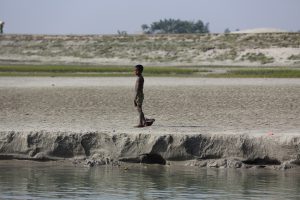Bilal Israel Khan has 500 acres of land in Sadiqabad, Rahim Yar Khan district of Pakistan’s Punjab province bordering Sindh. Farming since 1972, he grows sugar cane, cotton, wheat, maize and vegetables and oranges over 300 acres, although he would cultivate the full 500 acres if he could get enough water.
He is one of the growing number of “progressive farmers” who have long stopped flood irrigation practiced by their forefathers and replaced it with more efficient use of water.
He has adopted new technology and water saving techniques from necessity, rather than to boost productivity, because there is “just not enough water”, said Khan, speaking to thethirdpole.net over phone from his village called Chak 150/P. Khan practices tunnel farming, bed and furrow planting, which has reduced the area that needs to be irrigated. He also only irrigates at optimum times and uses drip irrigation.
Pakistan irrigation system
Khan’s farmland sits at the tail end of a canal system which is part of the wider Indus Basin Irrigation System – the largest contiguous irrigation system in the world. Irrigation in Pakistan has allowed agriculture to flourish, but water shortages are now a growing problem for farmers who extract over 90% of the country’s scare water resources.

But most farmers are not trying to save water. Farmers upstream at the top of canals, have “unrestricted access” to “stolen water” Khan says, and so have no need to adopt water conservation practices.
Khaleel Ahmed, a farmer in the same area estimated the amount of water stolen. “Many from my fraternity have illegally diverted anywhere between 1,200 cusecs to 2,800 cubic feet per second (cusecs) of water between Panjnad and Qasimwala.
“It is affecting 800,000 acres of agricultural land making our land barren,” said Khan. Many farmers, he lamented, had been compelled to give up cultivation.
The problem runs far deeper. For several years now, retired and current army personnel who own huge tracts of lands in the Cholistan desert at Qasimwala have pilfered huge amounts of water. “They have diverted an entire canal to green the desert and are growing water-guzzling crops like rice and sugar cane there,” said Khan.
“In Rahim Yar Khan, the demand today is 1,900 cusecs but we are getting only 554 cusecs in our canals. There is just not enough water in any of the rivers to meet the needs of everyone,” Sattar said. “Even the storage at Mangla and Tarbela [dams] are running on empty. In this climate of uncertainty, people resort to stealing the water”.
Even when the culprits are caught red-handed, nothing happens. “The very next day, we see them passing by our office, having paid the measly sum of a thousand or so rupees [USD 7],” he said, arguing that if the fine for stealing was increased, people would think twice before violating the law.
Hundreds of farmers from this part of the Punjab province regularly hold protest rallies in the city of Rahim Yar Khan against water theft. Farmers associations say the local police have booked 50 farmers who took part in the last protests and victimized the rest.
Poor water governance
Not everyone agrees that water theft is the real problem. Arif Anwar, heading the International Water Management Institute (IWMI) in Pakistan, finds little “factual evidence” to support the claims of farmers at the tail-end of the canals.
“On the surface of it – it usually looks like the fields at the head are more lush, but that may not be due to the distribution of the canal water; but because these farmers have access to groundwater which is usually of better quality near the head of the canal where that water seeps into the ground,” he pointed out.
However, Khalid Mohtadullah, a water policy expert and senior advisor to the International Centre for Integrated Mountain Development (ICIMOD), has observed “serious inequity” because of farmers at the canal head and the middle users, drawing “more than their share of water”.
“It’s a governance issue, if there was proper accountability, the tail-enders would surely get their share of water,” Mohtadullah said.
Out of luck with depleting canal water, Khan and farmers in his area cannot use the groundwater either even if they can afford to put up tube wells. “We’d only pump out brackish water and it would ruin the soil Ph with just one irrigation,” Khan explained. As a result the canal is their only source for irrigation and potable water. The canal closest to their district is the Abbasia canal emerging from Panjnad.
History of irrigation in Pakistan
Pakistan’s irrigation system, built by the British in the 1800s, is a complex network that brings water from the rivers to the canals and, in turn, through distributaries. The smallest channel through which farmers get their water is locally known as a “moga”, not more than six inches wide. Farmers receive water through a rotational system more popularly known as “warabandi”.

“The British designed the IBIS between 1847 to 1947 to turn 67% of the basin area into farmland, said Azeem Shah, regional researcher at IWMI. But since the British left in 1947, the government irrigation engineers have continued to add new dams, barrages, and link and branch canals to the old system. Today the IBIS has three large dams, 85 small dams, 19 barrages, 12 inter-river link canals, 45 canal commands and 700,000 tube wells, said Shah, IWMI’s spokesperson.
This has increased water demand immensely. Moreover, farmers no longer leave some of their land fallow. “When mechanization replaced the bullocks with tractors; and fertilizers and pesticides increased the yield, the farmers decided to grow on fallow land to earn more profits; thus more water was needed,” said farmer Khan.
Today the area irrigated by canals and tubewells in Pakistan has increased by 150% since 1947 says Shah. Roughly 50% of Pakistan’s irrigation needs are met by the Indus Basin Irrigation System canals and 50% is extracted from the ground.
Water shortages have hit a crunch point for many farmers. This year Khan’s cotton crop and sugarcane did extremely poorly. “I was not able to harvest even a kilogram of cotton compared to 1600 kg/acre in normal years,” said Khan.
He puts this down to water theft. “My manager was telling me today that we have suffered a loss of anywhere between PKR 40-50 million [USD 29,000-36,000] this year because of water theft. I had some savings so I am able to buy time, but what about farmers and those who rent their land…they must be contemplating suicide like the Indian farmers,” said Khan painting a gloomy picture.
Khan’s grievances are corroborated by Rabia Sultan, one of the directors of the Farmers Associates Pakistan.
“The law says the irrigation department has to check if any water theft is occurring, but obviously it is happening with their connivance,” said Sultan, who is among a handful of women farmers who own and cultivate land. She shuttles between her home in Lahore and her village Thatta-Gurmani in Muzaffargarh, 413 km away, where she grows cotton, sugar cane, vegetables and mangoes over 450 acres of farmland.

Bribes and corruption
Water theft occurs in different ways, explain farmers. Often influential people at the top of the canal increase the size of the “moga” or outlet. ” Khan sends photos and videos of the neighbouring village of Chak 152/P where an outlet has been widened to over 18 inches, the “diameter of a big barrel”. The land belongs to the army, whom he accuses of colluding to steal the water.
“You can hardly expect the irrigation department to confess that their department is taking bribes. But thousands of farmers will testify that graft is endemic,” said Khan.
There are many farmers who have resorted to paying heavy bribes to get their fair share of water. “They even get clerics to justify that Islam allows bribes for what is lawfully theirs,” said Khan.
The situation in Sindh is even worse, said Sultan. “In Sindh the farmers are either politicians or politically connected and will not let water go down beyond Kotri barrage,” she said.
The Nara canal, the longest of the 14 canals in Sindh, running for about 355 km above Sukkur barrage, is supposed to bring in 13,000 cusecs of water to the farmers at the tail end of the canal. But between 2,500 to 3,000 cusecs is swallowed between Sukkur up to Sanghar where huge tracts of farmland is owned by influential landlords, including those in the parliament, the army and the bureaucrats for their cotton, sugarcane, rice and wheat.
Like in Punjab, big landlords in Sindh pump the water directly from the distributaries to their land, said Mian Salim, president of the Red Chilli Growers Association. A physical survey carried out by one of the Sindh farmers’ associations, of which he is a member, found as many as 650 pumping machines strewn across that part of the canal and to which the water authorities turn a blind eye. Curiously, the chilli growers that thethirdpole.net spoke to said there was enough water released by upstream Punjab for Sindh. “The big cultivators [in Sindh] just have to stop stealing our water.”
This summer was a particularly bad season for chilli growers as there was no water for three months from March onwards, when the seedling is transplanted and needs regular watering.
A raft of woes
The problem is not only water theft. The canal system is a complete mess Sultan said, from the failure to de-silt the canals, to the “technically inexperienced” field officers who are rarely found in the field, or the bureaucrats who have no knowledge of agriculture or irrigation. “Over the years, the department has not invested in either its human resources or the infrastructure and both are in a terrible state,” she said.
She said it was important to review whether farmers are growing the right crops “based on ecological and climatic” factors. She gives the example of sugar cane that has been encroaching on prime land where cotton crop is to be grown. That is because mills have been set up by powerful people to process and export the crop. Sugar cane uses even more water than cotton and brings less profit, she explained.
In addition, while farmers should use modern methods of irrigation, Pakistan needs to develop indigenous low-effective technology, said Sultan. For example, drip irrigation was great for her mango orchards but it is “expensive and not every farmer will put up a system that costs PKR 150,000 [USD 1,077] per acre.”
Farmers like Sultan and Khan can provide a host of solutions but if the government implements existing irrigation laws, it would be enough to control water theft.
Strict punishment of violators and reasonable salaries for personnel working in the irrigation department would help stem the water theft, suggests Abdul Sattar from the Punjab irrigation department. This could be a starting point.




![Mapcha Khambab River in Tibet, China. Mapcha Khambab means peacock’s mouth in Tibetan and is named after a spring which is the spiritual source of the river. The river becomes the Karnali in Nepal and the Ghaghara in India [image by: Nabin Baral]](https://dialogue.earth/content/uploads/2019/01/Free_Wild-and-Scenic_Photo-Story-1-300x200.jpg)

![A Tibetan woman collects yak dung for cooking fuel in Kardung Village in Tibet. This is the first village on the bank of Karnali River (also called Mapcha Khambab) in Tibet [image by: Nabin Baral]](https://dialogue.earth/content/uploads/2019/01/Tibetan-woman-collects-dung-for-cooking-fuel-300x200.jpg)
